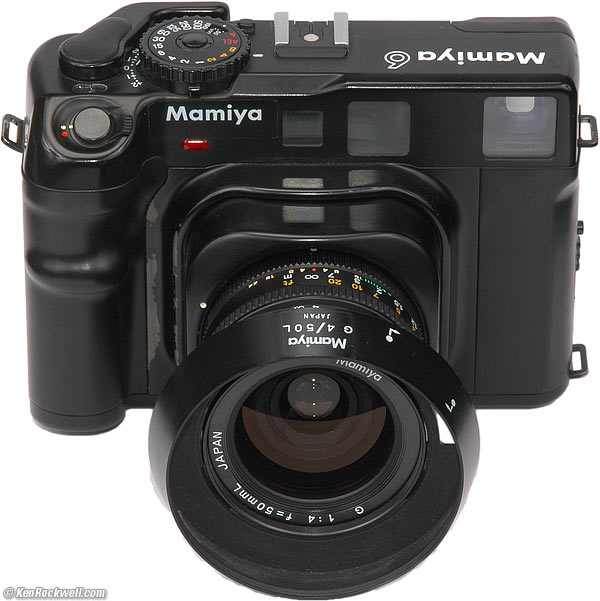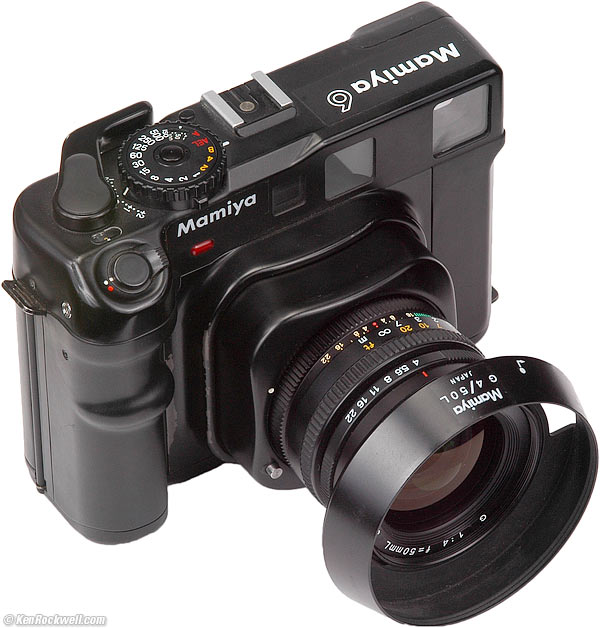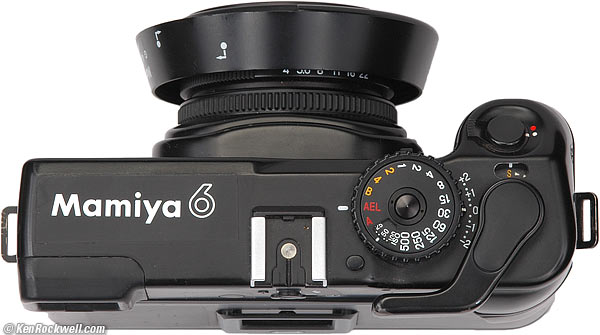Home Donate New Search Gallery Reviews How-To Books Links Workshops About Contact
Mamiya 6
6×6 cm Rangefinder (1989-1999)
Mamiya 6 and 50mm lens. enlarge. I got mine at this link to them at eBay. (see How to Win at eBay). This free website's biggest source of support is when you use that or any of these links when you get anything, regardless of the country in which you live. Thanks! Ken.
January 2016 More Mamiya Reviews All Reviews
Rangefinder vs. SLR cameras and lenses
Why Fixed lenses Take Better Pictures
Introduction
The Mamiya 6 system, introduced in May 1989, is a 6×6 cm (2¼" square) rangefinder camera taking 120 and 220 film with three interchangeable lenses of 50mm, 75mm and 150mm.
The Mamiya 6 does the same thing as a Hasselblad system with 50, 80 and 150 lenses, just that this Mamiya weighs much less, is much easier and faster to use and makes sharper images due to the silent and vibration free electronic leaf shutters and rangefinder-design lenses. 220 and 120 film are selected just by rotating the pressure plate; the Hasselblad requires separate backs! This rangefinder design is what makes the lenses better than the Zeiss SLR lenses exactly in the same way the Leica rangefinder lenses can outdo SLR lenses, especially for wide angles.
Although the Mamiya 6 is my favorite camera, the advantage of the Mamiya 7 is that its system includes wider lenses. I always seem to grab the Mamiya 7 and its 43 mm lens instead.
Mamiya 6 and 50mm lens. enlarge.
Versions and History
There are at least three versions of the Mamiya 6:
1940-1960: Mamiya 6
The first Mamiya 6 was a folding, fixed lens, mechanical camera with no meter.
It focused by moving the film plane instead of the lens.
Mamiya made about a dozen variations over the course of twenty years.
I am not discussing these cameras here.
1989-1993: New Mamiya 6
The New Mamiya 6, discussed here, came out in 1989. Except for the film format and name, it has nothing in common with the original Mamiya 6. It is called New Mamiya 6 among camera historians to differentiate it from the mechanical camera above, otherwise, everyone including myself simply call this the Mamiya 6.
This is my favorite version, and actually, my favorite camera of all time.
1993-1995: Mamiya 6MF
To try to pump up sales by adding worthless features to an otherwise perfect camera, Mamiya released the Mamiya 6MF.
The Mamiya 6MF, or Multi Format, had some idiotic multi format adapters available.
One of these adapters masked 6 x 6 film down to 6 x 4.5, making the top and bottom edges of the frame black, and still giving you the same 12 or 24 exposures.
The other stupid adapter allowed you to use 35mm film for making 24mm x 56mm panoramic shots. This is a dumb idea because the wider 35mm film costs as much per shot as the 120 or 220 film does, and limits your entire roll to that stupid format.
Smart people just shoot the full 6x6 aperture and crop later.
If you want 6 x 4.5 or 24mm x 56mm shots instead, then just crop from the 6x6 image. The film costs are the same, however if you are silly enough to use one of those cockamamie adapters you have locked yourself into that format for the whole roll. Also with the 6 x 4.5 adapter you now need to rotate the camera for vertical shots! With the 6x6 format, you can crop either way for free!
The reason the 6MF (Majorly Foolish) version is so hated today is because its finder is indelibly littered with the distracting blips trying to cover all the different "formats" at the same time, regardless of which you are shooting.
Apocrypha suggest an even newer version of the Mamiya 6 had the same bad spotmeter as the Mamiya 7, but I have never seen one. I hate the spot meter of the Mamiya 7, compared to the averaging meter of the Mamiya 6.
Overall Performance
The Mamiya 6 is the world's most perfect camera system.
The Mamiya 6 camera is better than the newer Mamiya 7 system in terms of convenience, which is the whole point of these cameras.
See the comparison between the Mamiya 6 and current Mamiya 7 here. Since there is no lens wider than the 50mm for the Mamiya 6, I use the Mamiya 7 with its larger film and much wider 43mm lens.
All three lenses collapse about 1.5" into the camera body, making a very compact camera. Heck, it weighs less and gets smaller than my Nikon. The Mamiya 7 cannot do this, and this is very, very important to me. This makes my medium format Mamiya more compact to carry than any of my Nikon SLRs. HA!
All lenses' fields of view are automatically selected through the Mamiya 6's viewfinder. This is unlike the Mamiya 7, which requires a stupid external finder for use with its two widest lenses.
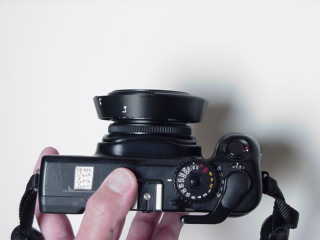
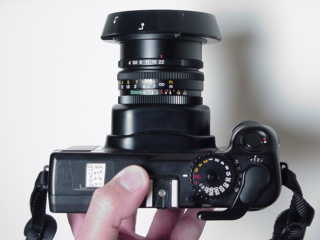
Mamiya 6 and 50mm lens collapsed (left) and extended (right).
Finder
The finder and magnification are fixed. What changes with different lenses is that different frame lines show.
At 50mm, the frame is almost the entire finder.
At 150mm, only a square in the middle of the finder is what you get on film.
Top, Mamiya 6, collapsed 50mm lens and reversed hood. enlarge.
Lenses
All three lenses are spectacular. The 50mm lens is one of the most perfect lenses I have ever used. It tests much better than the Zeiss Distagon for the Rolleiflex and the same as the Zeiss lens on the Hasselblad. See Photodo.com for details. Need I say more? The fact that these are rangefinder lenses and can be designed without having to work around the rear lens extension interfering with an SLR mirror allows the Mamiya 6's lenses to outdo the SLR systems. Don't get all serious about this, the Zeiss lenses are also excellent and any differences between these are invisible except in a laboratory.
All three lenses have their own electronic leaf shutters providing speeds from 4 seconds to 1/500 and Bulb. Manual shutter control is at full stops while automatic control is stepless. Apertures of course may be set anywhere and the meter reads this, too. Electronic shutter control gives perfect accuracy at slower speeds and is limited only by shutter efficiency issues at the very top speeds. The shutters never require calibration. They are far more accurate than any mechanical shutter as on most Leica, Hasselblad and large format cameras. Flash sync on all lenses is at all speeds including 1/500, which is twice the speed of any Canon, Nikon or Leica.
Infinite Depth-of-Field Trick
You can make use of my advanced perfect sharpness calculations to figure out what aperture to use to get the best sharpness anytime where you need depth of field and have a tripod so motion is not an issue. This has nothing to do with hyperfocal distances or circles of confusion or depth of field; it's a completely different sort of math solving for optimum sharpness also considering diffraction. Blindly setting f/22 can lose sharpness due to diffraction. You can read the mathematics here, but otherwise just use the aperture indicated by this table:
If the lens scale indicates |
then use |
f/32 |
f/32 1/2 |
f/22 |
f/32 |
f/16 |
f/22 1/2 |
f/11 |
f/22 |
f/8 |
f/16 1/2 |
f/5.6 |
f/16 |
f/4 |
f/11 1/2 |
Detailed instructions:
1.) Focus on the
closest thing you need sharp. Note the distance on the focus scale.
2.) Focus on the farthest thing you need sharp. Also note the distance
on the focus scale.
3.) Set the focus ring to midway between these two points and leave it
there for the photo.
4.) Presuming you really have the ring set midway between those two points
both the far and near readings will be next to the same aperture indication
on opposite sides of the depth-of-field scale. Read this aperture.
5.) Find that aperture on the left of the chart above and set the lens
to the corresponding aperture on the right side of the chart.
Example:
With the 50mm lens let's say you want everything from 10 feet to 20 feet as sharp as you can get. You'll set the lens to 14 feet, read f/4 from the lens depth-of-field scale, and set the lens to f/11 1/2. This will be far sharper than using the f/4 the camera scale suggests, since that scale is based on a just barely acceptable fuzziness for handheld shots, and f/11 1/2 will also be sharper then just defaulting to f/22 since it has less diffraction than f/22. The math is here if you care. The calculations behind this very simple procedure are very complex and add diffraction Airy disc effects to the traditional depth of field and blur circle calculations.
Filter Tricks
I've found an important side benefit to carrying and using only 67mm filters and a step-up ring to cover both the 58mm and 67mm filter sizes in the Mamiya 6 system.
One may stack more 67mm filters on the 58mm threaded lenses without vignetting than if one used 58mm filters.
This is important since it both saves carrying an extra dozen filters in a second size, and several filters can be stacked to create effects without vignetting.
For instance, an 85C, an FLD and a grad ND will turn a blah sunset into an epic one.
I have found that using 67mm filters I can use 2 or 3 on the Mamiya 6 50mm, and 5 (yeah, five) on the Mamiya 6 75mm lens with no vignetting.
See more about how to use filters like graduated ND and polarizers on the filter page here.
Light Meter
The light meter is an averaging meter that reads the light coming through most of the viewfinder's area. That means that you have a mild center weighting with the wide lens, no weighting with the normal lens, and read outside the field of view with the telephoto lens. This can be adjusted a little bit by the factory with baffles inside the viewfinder and metering system. I wish it was a little more center weighted. See tips below.
The Mamiya 6's averaging meter is completely different from the Mamiya 7's spot meter. Mamiya's literature and Mamiya USA's salespeople who read this literature are mistaken here. Go try for yourself as I do and see.
It is extremely sensitive and accurate and can be tricked into making accurate measurements into the minute range. See the tips in the next section.
Mamiya makes me laugh. They list different relative angles of view for different lenses. This is because the metering area remains the same but the lens' angle of view is changing!
I only use the meter in AEL or A mode, in which case it is effectively stepless.
The built-in meter is sort of useless in manual mode because it only reads to full stops. Unlike every other manual meter, there is no "0" or null indication to show you the correct exact exposure. Because of this you may be off as much as a half stop and not know it. This is critical for slides, unimportant for negatives.
You ought to wiggle the aperture ring in manual mode and use the aperture setting in the middle of the range over which your chosen shutter speed is indicated.
As most cameras, manual shutter speeds go in full stops and lens apertures are continuously variable.
Metering Tricks
Filters
When using filters dial the compensation into the camera manually. For a Tiffen screw-in neutral-density Grad ND 0.6 I just dial in +1 and fire away, easy. For a Polarizer I dial in the amount I've measured by previous tests, since polarizers vary. Most need +1 2/3 stops. You can use regular cheap linear polarizer filters. You cannot see the effect through the viewfinder, since the viewfinder is polarized. Watch it, because of this you may be seeing effects that you won't see on your film. Only use the viewfinder for composition, focus and exposure reading. Look through your filters held up to your eye to see the polarization effects. You may be able to hold a circularly polarized filter up to the viewfinder and see the effect accurately. I have not tried it.
Even with the polarized view through the finder I have not seen exposure errors with heavily polarized subjects. This tells me that the meter is not reading through the polarized section.
See more on my filter page about how to use graduated ND filters and polarizers here.
Manual or Auto Exposure?
Manual exposure readings only read to the nearest full stop, so you will only be within a half stop in manual metering mode. This makes the manual meter kind of useless. Because of this I prefer the AEL mode for everything. Otherwise, if shooting transparencies I suggest dithering the aperture ring and finding the aperture that causes the camera to read in the center the indicated shutter speed. Remember, manual speeds only set in full stops, and in the auto modes they set to any speed they need.
Exposure Compensation
Quick exposure compensations are made by holding the shutter button partway down to lock the exposure in AEL and shifting the aperture ring a click or two whichever way you want it.
Night Photography
In extremely low light where you need more than 4 seconds of exposure, set the meter to a faster film speed (and add negative exposure compensation if needed), make your reading manually, and then convert to the longer exposure time in your head.
For instance, at night I prefer to set the camera to a film speed six stops faster than my film and set the exposure manually. In this case the meter reads directly in minutes, since six stops is a factor or 64 times, the same difference as a second is to a photographic minute. (A photographic minute is 64 seconds long.)
For Velvia 50, I set the meter to EI 1,600 and minus one stop exposure compensation, for an equivalent of EI 3,200 (3,200 = 50 x 32).
If the meter reads 1/4 second at f/5.6 I use a quarter minute (16 second) exposure at f/5.6. 16 seconds is 1/4 of a photographic minute.
For the less mathematically inclined, here are the numbers. Remember to set film speed six stops faster and then use this table:
If meter reads (at six stops higher film speed) |
Then use this exposure |
1/60 |
1 sec |
1/30 |
2 sec |
1/15 |
4 sec |
1/8 |
8 sec |
1/4 |
16 sec |
1/2 |
32 sec |
1 |
64 sec |
LT |
1 - 4 minutes |
Note: add exposure if required due to reciprocity effects particular to your film.
If it's still too dark, take your reading at a larger apertures and do more math in your head to calculate the exposure at your taking aperture. For instance, if you get two seconds at f/4, use 16 seconds at f/11.
Flash
Flash is a no-brainer. The Mamiya 6, like almost all larger format cameras, is decades behind AF 35mm SLRs here. This means you can use any flash, even flashbulbs, with it. There is no TTL mode or dedication to worry about.
Flash Sync is any speed up to and including 1/500, faster than any Leica or any 35mm film SLR, thus its also decades ahead of any 35mm SLR.
Of course there is a PC sync terminal for use in the studio.
For flashbulbs you only have X-sync. See the exposure recommendations for each flashbulb on the box.
I prefer any electronic flash with an A or AUTO mode. I use the tiny Nikon SB-E (20 years old and worth $30).
Simply set the flash to an auto setting that gives you enough range, and set that aperture on the camera.
Automatic Fill Flash mode
For automatic fill flash just set the camera and any electronic flash to each one's "A" mode.
Now set the camera to an aperture one stop less than the flash's calculator indicates. You will have fill flash automatically balanced to ambient light with any flash with an A mode made in the past 30 years. The newest Nikon SB-28DX and oldest Vivitar 283 flashes all work great. There are no dedicated contacts to worry about, so any dedicated new flash should work as well as an old flash from a garage sale.
In other words, if the calculator on the flash says use f/5.6 at the film speed you are using, set the camera instead to f/8. Now use the camera's A mode. The camera will automatically adjust itself for the ambient light, and the flash will automatically adjust itself for just the right amount of fill.
In other words, with my old Nikon SB-E flash the one auto mode asks for f/4 for Velvia for an auto range out to 10 feet. I set the Mamiya 6 to A and the lens to f/5.6 and I get perfect fill flash.
To adjust the fill ratio, just change the flash's auto setting or the camera's f/stop. For less fill, set the camera two stops below what the flash indicates. For very heavy fill (using the same aperture on the camera indicated by the flash) set the camera's compensation to -1 stop, otherwise you'll have full flash exposure AND full ambient exposure adding up to a stop of overexposure unless you dial in some - compensation on the camera.
User's Manual
Here's the manual from the Mamiya NL site.
Battery Life
I get three to four years on a pair of S76 button cells. The finder LEDs start to flash when each cell gets down to about 1.28V open-circuit and the camera still works properly.
If you continue to ignore this and the batteries get deader (since it will have been three years later when this starts to happen and you may not realize what the blinking LEDs mean) the finder still lights up, but the lens's shutter will not open when you press the (electronic) shutter button. The camera's mechanics will click and you may think you got your shot when in fact there was no shutter opening.
You'd never know this, except I thought something was amiss when making time exposures. I got a much softer click when I pressed the cable release on Bulb, and then got the normal sound on releasing it. What happened is that the batteries were too dead to open the lens's electronic shutter, although the camera's hand-wound mechanics were fine.
Therefore, replace the batteries when the meter blinks in Auto mode. I'll be honest, I have run the camera a year this way and not really had much of a problem except with some long time exposures didn't open as I mentioned. There are so many blinking lights I didn't realize that is what was going on, and shorter exposures were fine.
Rangefinder
Like many rangefinder cameras it may need to be adjusted to match your lenses to get the very best results, especially with the 150mm lens at f/4.5. More here about this. Once adjusted my Mamiya 6 has not shifted, unlike my Mamiya 7 which seems to need more periodic adjustment.
How to check a system
Like all rangefinder (RF) camera systems, the Mamiya 6's rangefinder needs to be correctly calibrated to each lens. When buying lenses one needs to ensure that the new lens is calibrated correctly to match the lenses you already own, since adjusting individual lenses outside the factory in Japan is iffy at best.
Even at its worst this is not a problem with the 75 and 50 lenses stopped down. It's most critical with the 150 shot wide open. Often systems will be off with the 150 shot wide open unless you're careful.
The good news is that so long as your lenses all match, even if your rangefinder gets a little bit off with time, that you can compensate for it.
Simply see where you need to set the focus of a lens to get perfect correlation on something at least a few miles away. Note where the infinity mark is on the depth of field scale. Now all you need to do for each shot is to focus using the rangefinder, and move the focus ring back the same amount that it takes to move the infinity mark in your test. In other words, if you get perfect correlation when the infinity mark is at the f/4 mark, just move the focus ring enough after focusing with the rangefinder to bring whatever's at the f/4 mark back to the center mark.
Of course this only works if the rangefinder is off in the direction that leads you to focus too closely. If you can do this then you may ignore bothering to recalibrate the rangefinder, since the effort, for a small misadjustment, isn't worth it. You only need to worry when using the 150 mm lens at large apertures, in normal use the typical drifts of the Mamiya 6 rangefinder, at least mine anyway, is invisible on film with the other lenses and the 150 mm stopped down.
The lenses, so long as no moron has messed with it, never vary once they leave the factory. Do not ever try to adjust one yourself. You will forever spoil whatever precision it used to have.
Regardless of the body's RF calibration, when set to the lens' infinity stop the image is almost always correctly focused at infinity on film, even if the RF says otherwise. It only will be off if some idiot tried to adjust his lens or camera at home, or if your body got run over by a truck. Confirm this on film first at full aperture with your longest lens. If it's OK then it's easy to have the RF on the body adjusted.
Look through the finder. The RF should give perfect, not close, but absolutely, positively, perfect correlation on an extremely distant subject. Be sure to look at an object like a mountain top at least several miles away. The M6 RF is so precise that it will discriminate between objects at infinity and objects a mile away. If you live in a congested area and the farthest thing you can see is only a mile away, DO NOT EVEN THINK about screwing with these adjustments. Try the moon at night.
If it's not completely perfect, take your Mamiya 6 to a specialist repair place for professional adjustment. Don't even think about doing it yourself. Even if you can get it right, it will be apparent from the tool marks you leave on the access cover that an unauthorized person has been playing with the adjustment, which completely eliminates any resale value your Mamiya 6 might have had. No one wants a delicate camera like this that any hobbyist, regardless of how careful and well-intentioned, has screwed with.
Your service man needs to disassemble the entire camera to be able to unlock the locking nut for the adjustment. Don't adjust this at home. One screw is for vertical adjustment (not terribly important) and the other is for horizontal adjustment, which is critical.
Once you get the RF to correlate at infinity for one lens and you already know the on-film image is in focus at infinity you're half way there. Go make test shots at full aperture at various distances and look at your film. It should be dead on. If it isn't try again.
Do this with the 150mm lens first if you have more than one lens. This adjustment is most critical for the 150 due to it's small depth of field and thus small margin for error at f/4.5.
Now that you have one lens set properly you can confirm that each successive lens you buy also gives perfect correlation at infinity. Just look through your calibrated finder on a very, very distant object with the lens set to the infinity stop. If it doesn't correlate PERFECTLY don't buy the lens, period. Close isn't good enough; just buy a different lens.
Personally I had to sort through a lot of lenses to get a set that matches.
Screwy Options
Closeup Attachment
Just like the panoramic options, pass on the corny closeup contraption. A used close-up attachment is worth about $100.
I had one for my 6 and sent it back. It only gets you a little closer and is a real pain to carry around and still you are composing from the wrong point through a rangefinder. I get much better results just cropping from the big film and not bothering to carry this contraption around! It's just a close-up lens and a prism for the finder. You also can buy your own high-quality close up lens for cheap (get the two element Canon or Hoya versions) and bring some string to measure the distance. Optical quality was poorer than just blowing up from the center; it's just a close up lens, not an extension tube or dedicated macro lens. That's why these are so rare; no one bought them because they sucked. The only use is if you want to project your transparencies for conventional slide shows and prefer a softer image that fills the film, otherwise save yourself the hassle and blow it up if you need to in scanning and printing.
No rangefinder is good for closeups. A pocket digital camera still works better.
Multi-Format and Panoramic
These options are just gimmicks you may ignore.
The pan option only makes sense in the rare case that you happen both to be a full time pro and that you intend to present a portfolio to clients as original transparencies.
In this rare case it may look a little neater to have the transparencies already cropped in-camera as they are with this idiotic option. Even in this case it's a waste of time: there are no standard mounts or pages for that pan format anyway (just mounts in non-pan sizes masked down to pan apertures), so it still looks stupid.
Not only that, using 35mm film in the pan adapter costs as much as 6x7 film per shot. Even worse, using the pan adapter commits you to that format for the whole roll. Use no pan adapter and crop the few you may want as pan shots and you'll be much better off.
Service and Reliability
Mamiya isn't the best made camera. The results are extraordinary, but things fall off now and then.
Expect that the eyecup may fall off. Otherwise, I've had a lens focus ring come loose, but no big deal, I had micro screwdrivers with me and tightened it back up.
Otherwise,, beyond that and the usual rangefinder adjustments, I've never had a problem.
As of March, 2010, Mamiya still services them.
The only gotcha is if you have film-advance problems. 90% of the time Mamiya can fix those, too, but they no longer have those particular parts. If you've got one of the 10% of cameras with a film-advance problem that they can't fix, then you'd be out of luck. If so, I'd try Gus Lazzari, who seems to be able to fix anything.
Flange Focal Distance
I roughly tried to measure mine freehand (without the proper jigs to do this correctly), and read about 56.2 ±0.2 mm.
How to Buy One
As of 2016, they only come used. They were frighteningly expensive when new; these below are all used prices.
I got mine at this link to them at eBay.
In 2010 and 2016, a Mamiya 6 and 75mm lens usually sell for around $1,100.
In 2010, the 50mm lens sold for about $700 and the 150mm lens for about $350.
Be sure to get the special hoods with each lens; I don't know that they are available separately.
In May 2005 $2,500 was about right for a complete system with all three lenses and extra goodies.
Here are the rough values people paid each other for these in May 2005:
Body
only: $900 (6MF and plain 6 worth the same)
Body and 75mm lens: $1,100
50mm:
$900
75mm lens: $350
150mm lens: $300
© Ken Rockwell. All rights reserved. Tous droits réservés.
Help me help you top
I support my growing family through this website, as crazy as it might seem.
The biggest help is when you use any of these links to approved sources when you get anything, regardless of the country in which you live. It costs you nothing, and is this site's, and thus my family's, biggest source of support. These places have the best prices and service, which is why I've used them since before this website existed. I recommend them all personally.
If you find this page as helpful as a book you might have had to buy or a workshop you may have had to take, feel free to help me continue helping everyone.
If you've gotten your gear through one of my links or helped otherwise, you're family. It's great people like you who allow me to keep adding to this site full-time. Thanks!
If you haven't helped yet, please do, and consider helping me with a gift of $5.00.
As this page is copyrighted and formally registered, it is unlawful to make copies, especially in the form of printouts for personal use. If you wish to make a printout for personal use, you are granted one-time permission only if you PayPal me $5.00 per printout or part thereof. Thank you!
Thanks for reading!
Mr. & Mrs. Ken Rockwell, Ryan and Katie.
Home Donate New Search Gallery Reviews How-To Books Links Workshops About Contact
